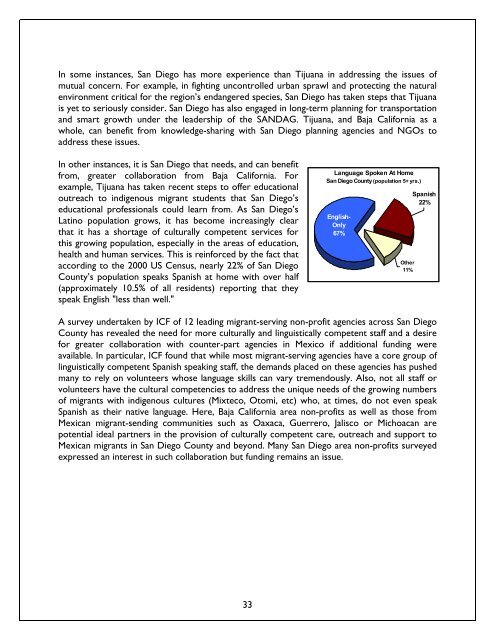Blurred Borders - International Community Foundation
Blurred Borders - International Community Foundation
Blurred Borders - International Community Foundation
You also want an ePaper? Increase the reach of your titles
YUMPU automatically turns print PDFs into web optimized ePapers that Google loves.
In some instances, San Diego has more experience than Tijuana in addressing the issues of<br />
mutual concern. For example, in fighting uncontrolled urban sprawl and protecting the natural<br />
environment critical for the region’s endangered species, San Diego has taken steps that Tijuana<br />
is yet to seriously consider. San Diego has also engaged in long-term planning for transportation<br />
and smart growth under the leadership of the SANDAG. Tijuana, and Baja California as a<br />
whole, can benefit from knowledge-sharing with San Diego planning agencies and NGOs to<br />
address these issues.<br />
In other instances, it is San Diego that needs, and can benefit<br />
from, greater collaboration from Baja California. For<br />
example, Tijuana has taken recent steps to offer educational<br />
outreach to indigenous migrant students that San Diego’s<br />
educational professionals could learn from. As San Diego’s<br />
Latino population grows, it has become increasingly clear<br />
that it has a shortage of culturally competent services for<br />
this growing population, especially in the areas of education,<br />
health and human services. This is reinforced by the fact that<br />
according to the 2000 US Census, nearly 22% of San Diego<br />
County’s population speaks Spanish at home with over half<br />
(approximately 10.5% of all residents) reporting that they<br />
speak English "less than well."<br />
A survey undertaken by ICF of 12 leading migrant-serving non-profit agencies across San Diego<br />
County has revealed the need for more culturally and linguistically competent staff and a desire<br />
for greater collaboration with counter-part agencies in Mexico if additional funding were<br />
available. In particular, ICF found that while most migrant-serving agencies have a core group of<br />
linguistically competent Spanish speaking staff, the demands placed on these agencies has pushed<br />
many to rely on volunteers whose language skills can vary tremendously. Also, not all staff or<br />
volunteers have the cultural competencies to address the unique needs of the growing numbers<br />
of migrants with indigenous cultures (Mixteco, Otomi, etc) who, at times, do not even speak<br />
Spanish as their native language. Here, Baja California area non-profits as well as those from<br />
Mexican migrant-sending communities such as Oaxaca, Guerrero, Jalisco or Michoacan are<br />
potential ideal partners in the provision of culturally competent care, outreach and support to<br />
Mexican migrants in San Diego County and beyond. Many San Diego area non-profits surveyed<br />
expressed an interest in such collaboration but funding remains an issue.<br />
33<br />
Language Spoken At Home<br />
San Diego County (population 5+ yrs.)<br />
English-<br />
Only<br />
67%<br />
Other<br />
11%<br />
Spanish<br />
22%















